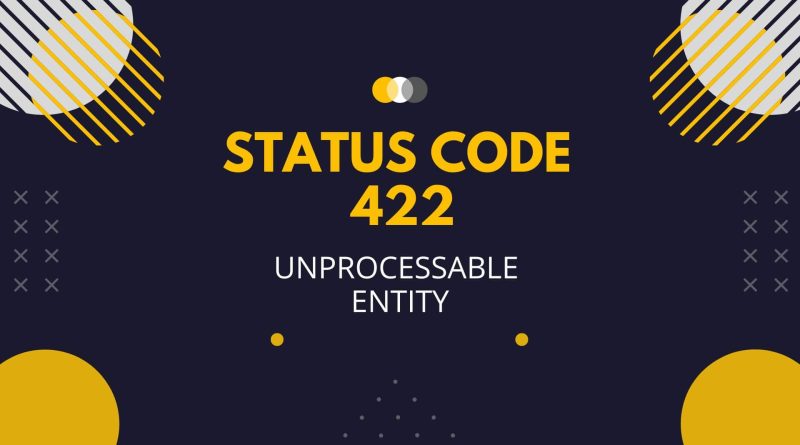Status Code 422: What Is It and How to Fix it
If you’ve ever encountered a Status Code 422 Error while using any type of web service, then you know how frustrating it can be. But what is Status Code 422 exactly? Understanding what causes the 422 error to appear in the first place is essential to troubleshooting this issue and resolving it quickly and easily. In this blog post we will discuss what a Status Code 422 means, the various scenarios when it could present itself, as well as best practices for fixing or avoiding it in the future.
What are the status codes?
Status codes are server response codes found in HTTP requests of Hypertext Transfer Protocol (HTTP). They dictate how the server responds to a request, whether with a successful response or an error. Status codes help enable web developers to quickly understand why a client’s request failed and fix any potential issues. Furthermore, status codes allow us to keep track of server requests and debugging processes. As such, it is important to be familiar with the various status codes and their meanings when developing for the web.
What is the Status Code 422 unprocessable entity?
The HTTP status code 422 indicates that the request was properly formed, but it was unable to be followed due to semantic errors. This status code is typically used in situations where the user has sent a request in the correct format, but the request has semantically incorrect or incomplete information.
There are several possible causes for a 422 error, as it indicates that the server understands the request but it is unable to process the contained instructions due to semantic errors. Some common causes for this error include:
- Missing or incomplete information: If the request entity does not include all of the necessary information or if it is inaccurate, incomplete, or invalid, a 422 error will be sent back from the server.
- Conflict with the current state of the resource: If the user attempts to submit information that has become outdated, the server may return a 422 error, meaning that their request can not be completed as this particular resource was altered since it had been last accessed.
- Validation errors: When a request includes user input that fails to pass the validation checks, then the server will respond with a 422 error signifying that this particular request is unable to be processed.
- Incorrect request syntax: If a request is formatted incorrectly or it is not syntactically correct, then the server will deliver a 422 error in return.
- Unsupported media type: When the server is unable to handle a request due to an unrecognized media type, it may respond with an HTTP 422 error.
- Inconsistencies in data: If the request contains contradictory or conflicting data, then a 422 error will be issued by the server.
Server side or client error
The 422 (Unprocessable Entity) status code indicates that although the server is able to understand the content of the request, it cannot process it. This type of error as it was mentioned earlier it is usually caused by a logical problem with the server-side architecture or with the provided data itself. Consequently, this type of error should be considered a server side error. However, errors that occur prior to reaching the web server on which your application is hosted can also be caused by client side issues such as incorrect URLs or typos in the domain name. Analysing and diagnosing both types of issues is key to resolving them promptly.
How to fix status code 422
To fix a 422 error, you will need to identify and correct the semantic errors in the request that are causing the error to be returned. Some steps you can take to fix a 422 error include:
- Review the request: Carefully scrutinize the request to guarantee that all essential information is provided accurately and coherently.
- Check for syntax errors: Thoroughly examine the request for any errors in syntax, such as superfluous or absent characters and punctuation misusage.
- Validate user input: To guarantee that user-submitted data meets all of your requirements, always validate it to ensure the input is in its correct form before responding to any requests.
- Check for conflicting data: Resolve any inconsistencies or conflicts in your requests to fix the mistakes. When there are data mismatches, solve them at once so that you can successfully address errors.
- Ensure that the request is properly formatted: To ensure that your request is compatible with the relevant HTTP specification or API documentation, it’s essential to format it correctly.
- Check for unsupported media types: If the request you have made includes a media type that cannot be processed by your server, consider switching to a different media type or providing supplementary information so that the server can process it without issue.
Status code 402 example
Here is an example of a request that might receive a 422 response code:
Request:
POST /users/register
Content-Type: application/json
{
"name": "Dave Smith",
"email": "[email protected]",
"password": "123abc"
}The request in this example is attempting to create a new user with the provided username, email address and password. But if the server has an official requirement that passwords must be of minimum 8 characters long, and the submitted password does not satisfy such criterion, then it will return a 422 error response as shown below:
Response:
HTTP/1.1 422 Unprocessable Entity
Content-Type: application/json
{
"error": "Password must be at least 8 characters long"
}This request was properly framed, and the server detected an issue with it – that is, the password failed to meet its minimum length requirement. Unfortunately though, due to this semantic error in particular, processing of the request could not be completed. The 422 response includes a comprehensive explanation of the problem for easy understanding by users; thereby allowing them to edit their mistake and retry sending in their request again.
Similar status codes
While the 422 error code, which stands for “Unprocessable Entity,” is fairly unique, there are a few other status codes that have similar descriptions. The 409 Conflict error code indicates that the request could not be processed due to a conflict between two or more requests. The 507 Insufficient Storage error code implies that the server has run out of storage space and cannot store any additional data in relation to the request sent. Lastly, the 423 Locked error code means that the requested resource is being intercepted by another process and is thus unavailable for processing. All of these codes might not apply to every website or application, but knowledge of them can certainly benefit developers who are looking for solutions when errors like 422 occur.
All HTTP status codes by categories
Informational responses
(100 – 199)



